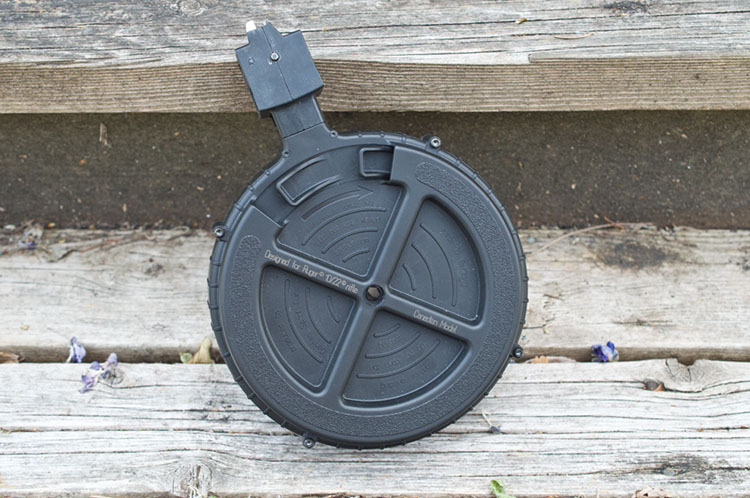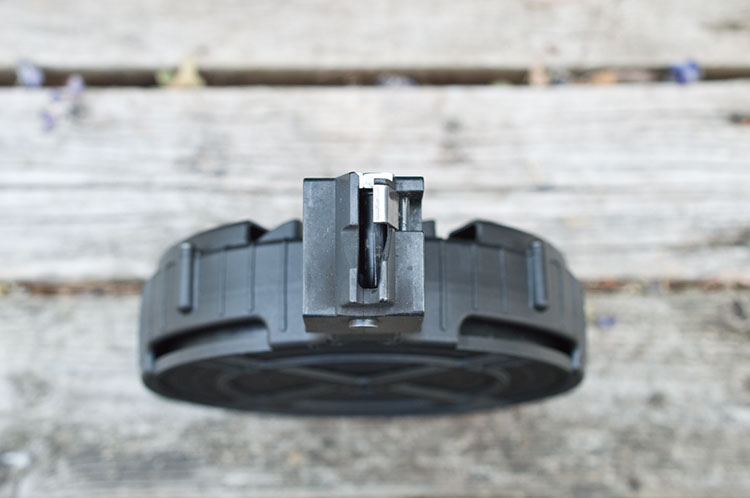
Magazine capacity limits are, in a word, silly. However they are the law and as such, if you want to have fun with more than a handful of rounds with your long arm, it best be chambered in a rimfire calibre. And one of the most popular rimfire rifles in existence is the Ruger 10/22.
Which is great for us Canadians, because no other rimfire rifle has attracted nearly the same amount of attention from the aftermarket as has the venerable Ruger. From aftermarket triggers to barrels to stocks, you could quite easily build a 10/22 of your own design out of the various parts available, and summarily feed it from any number of various aftermarket magazines stretching from 10 to 100 rounds. Yes, you read that right, there are 110-round magazines for the 10/22… and you can even get them here in Canada.
 Manufactured by German Sport Guns and imported by Blue Line Solutions, this 110-round drum magazine is perhaps the largest legal capacity magazine in the country available to the average PAL holder, and is emblazoned “Designed for Ruger 10/22 rifle – Canadian Model” specifically to ensure that any questions about its legality are moot. And it’s hefty too. If you expect this to be some kitschy piece of hard and brittle plastic you’re in for quite a surprise. Manufactured in Germany, this drum magazine is made from heavyweight plastic and weighs almost a pound empty, and about two pound fully laden down. That’s because the plastic moldings are a full four millimetres thick, are joined together with a steel Torx cap head screws, and topped off with a molded aluminium magazine head and steel lip insert. In short, it’s beefy.
Manufactured by German Sport Guns and imported by Blue Line Solutions, this 110-round drum magazine is perhaps the largest legal capacity magazine in the country available to the average PAL holder, and is emblazoned “Designed for Ruger 10/22 rifle – Canadian Model” specifically to ensure that any questions about its legality are moot. And it’s hefty too. If you expect this to be some kitschy piece of hard and brittle plastic you’re in for quite a surprise. Manufactured in Germany, this drum magazine is made from heavyweight plastic and weighs almost a pound empty, and about two pound fully laden down. That’s because the plastic moldings are a full four millimetres thick, are joined together with a steel Torx cap head screws, and topped off with a molded aluminium magazine head and steel lip insert. In short, it’s beefy.
But as any experienced semi-automatic rimfire owner knows, durability is the lesser half of the battle when it comes to magazines; anyone can make a magazine tough but reliability is an entirely different matter. And in this regard, the 110-round drum didn’t let us down. However there are some caveats.
The first is that the magazine must be loaded correctly. Obviously it cannot be loaded like a conventional magazine in which each concurrent round is simply pressed downward. The drum’s internal snail falling flat atop one another, which can cause problems both with loading and feeding. Conversely, if not enough pressure is taken off the round being loaded it can end up putting too much pressure on the rounds atop the vertical column, and causing issues with the rounds as they load into their respective slots on the internally rotating drum mechanism.

We were informed of these crucial caveats prior to our testing of the magazine, and after adhering to the instructions we were given, were rewarded with almost trouble-free operation. Fitting the magazine to the rifle we noticed that the cast aluminium magazine body fit quite snugly, and afforded little in the way of play; probably a good thing given the magazine weighs so much. And when it came time to shoot, we had no problems with the magazine… as long as the rifle was clean. As our gun gummed up with the crud and crap that .22s always seem to get coated with, we did find a fully loaded drum gave us some issues as the bolt struggled to strip a fresh round from a relatively full magazine. However, that was after many hundreds of rounds downrange, and is largely unavoidable as the spring tension required to push a 110-round column around a drum and up into a gun is something of a fixed commodity and will exert a decent amount of pressure on the top round. And as your gun binds up with carbon and grit, the bolt will move more slowly through the action, and may not have enough energy to overcome that pressure on the top round. We noted that this issue pretty much disappeared after we’d fired 20 to 25 rounds.
So now for the elephant in the room: This magazine is not cheap. If you’re want the ability to wander around with 110 rounds of .22LR loaded up in your 10/22 or 10/22 clone you should expect to spend a hundred bucks to do so. However, what you get in exchange for your hard-earned money is a seriously solid magazine that feels very well made and functions as well as pretty much any larger capacity rimfire magazine. Now if only we could find some .22 to feed it!